
USS Brooklyn was a sloop-of-war authorized by the U.S. Congress and commissioned in 1859. Brooklyn was active in Caribbean operations until the start of the American Civil War at which time she became an active participant in the Union blockade of the Confederate States of America.
The third USS Dolphin was the brig in the United States Navy. Her plans were the basis of other brigs of that time. She was named for the aquatic mammal.

The first Vandalia was an 18-gun sloop-of-war in the United States Navy during the Second Seminole War and the American Civil War. She was named for the city of Vandalia, Illinois.

The first USS Pawnee was a sloop-of-war in the United States Navy during the American Civil War. She was named for the Pawnee Indian tribe.

USS Merrimack, also improperly Merrimac, was a steam frigate, best known as the hull upon which the ironclad warship CSS Virginia was constructed during the American Civil War. The CSS Virginia then took part in the Battle of Hampton Roads in the first engagement between ironclad warships.

The first John Adams was originally built in 1799 as a frigate for the United States Navy, converted to a corvette in 1809, and later converted back to a frigate in 1830. Named for American Founding Father and president John Adams, she fought in the Quasi-War, the First and Second Barbary Wars, the War of 1812, the Mexican–American War and the American Civil War.
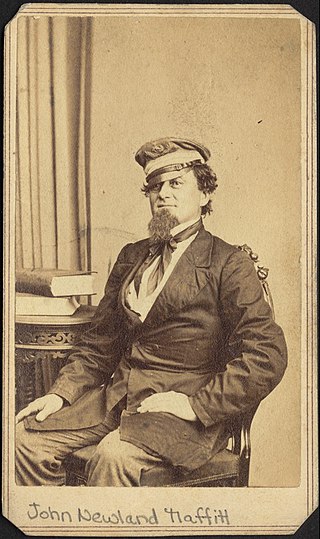
John Newland Maffitt was an officer in the Confederate States Navy who was nicknamed the "Prince of Privateers" due to his success as a blockade runner and commerce raider in the U.S. Civil War.
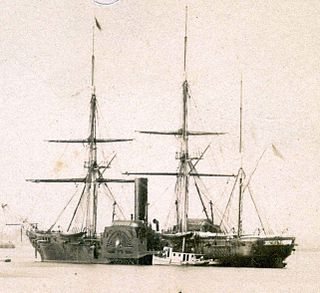
USS Susquehanna, a sidewheel steam frigate, was the first ship of the United States Navy to be named for the Susquehanna River, which rises in Lake Otsego in central New York and flows across Pennsylvania and the northeast corner of Maryland emptying into the Chesapeake Bay.

USS St. Lawrence was a frigate in the United States Navy that saw service during the mid-19th century, including the American Civil War. She was based on the same plans as USS Brandywine.
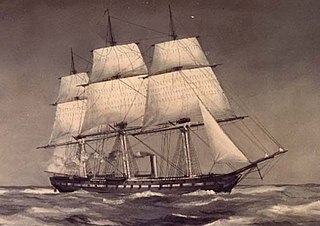
USS Wabash was a steam screw frigate of the United States Navy that served during the American Civil War. She was based on the same plans as Colorado. Post-war she continued to serve her country in European operations and eventually served as a barracks ship in Boston, Massachusetts, and was sold in 1912.
USS Germantown was a United States Navy sloop-of-war in commission for various periods between 1847 and 1860. She saw service in the Mexican–American War in 1847–1848 and during peacetime operated in the Caribbean, in the Atlantic Ocean off Africa and South America, and in East Asia. Scuttled at the outbreak of the American Civil War in 1861, she was captured and refloated by the Confederate States of America and placed in service with the Confederate States Navy as the floating battery CSS Germantown before again being scuttled in 1862.
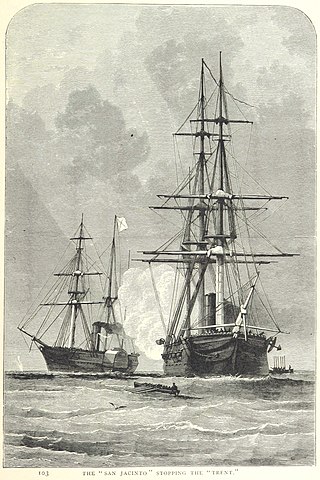
The first USS San Jacinto was an early screw frigate in the United States Navy during the mid-19th century. She was named for the San Jacinto River, site of the Battle of San Jacinto during the Texas Revolution. She is perhaps best known for her role in the Trent Affair of 1861.

The first USS Ossipee was a wooden, screw sloop-of-war in commission in the United States Navy at various times between 1861 and 1889. She served in the Union Navy during the American Civil War. She was named for the Ossipee River of New Hampshire and Maine. The USS Ossipee was present during the Alaska Purchase.

The first USS Pocahontas, a screw steamer built at Medford, Massachusetts in 1852 as City of Boston, and purchased by the Navy at Boston, Massachusetts on 20 March 1855, was the first United States Navy ship to be named for Pocahontas, the Algonquian wife of Virginia colonist John Rolfe. She was originally commissioned as USS Despatch – the second U.S. Navy ship of that name – on 17 January 1856, with Lieutenant T. M. Crossan in command, and was recommissioned and renamed in 1860, seeing action in the American Civil War. As Pocahontas, one of her junior officers was Alfred Thayer Mahan, who would later achieve international fame as a military writer and theorist of naval power.
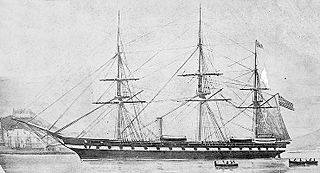
USS Roanoke was a wooden-hulled Merrimack-class screw frigate built for the United States Navy in the mid-1850s. She served as flagship of the Home Squadron in the late 1850s and captured several Confederate ships after the start of the American Civil War in 1861. The ship was converted into an ironclad monitor during 1862–63; the first ship with more than two gun turrets in history. Her conversion was not very successful as she rolled excessively and the weight of her armor and turrets strained her hull. Her deep draft meant that she could not operate off shallow Confederate ports and she was relegated to harbor defense at Hampton Roads, Virginia for the duration of the war. Roanoke was placed in reserve after the war and sold for scrap in 1883.
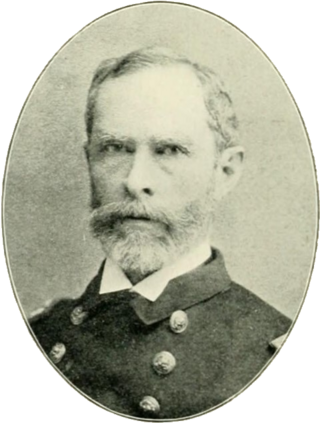
Edward Dunham Robie was a naval engineer, inventor, and Union naval officer during the American Civil War.
The first USS Onward was a clipper in the Union Navy.

USS Fulton was a steamer that served the U.S. Navy prior to the American Civil War, and was recommissioned in time to see service in that war. However, her participation was limited to being captured by Confederate forces in the port of Pensacola, Florida, at the outbreak of war.

USS Huntsville was a steamer acquired by the Union Navy during the American Civil War. She was used by the Navy to patrol navigable waterways of the Confederacy to prevent the South from trading with other countries.

USS Perry was a brig commissioned by the United States Navy prior to the American Civil War. She was tasked by the Navy for various missions, including those related to diplomatic tensions with Paraguay, the Mexican–American War, the slave trade, and the American Civil War. She was probably named after Commodore Oliver Hazard Perry.


















